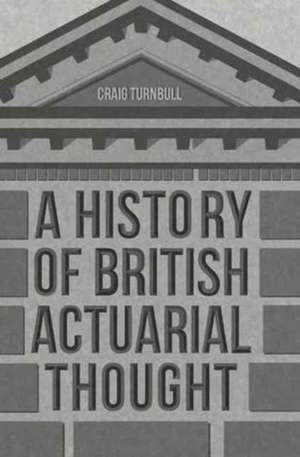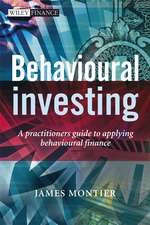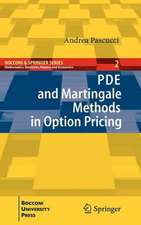A History of British Actuarial Thought
Autor Craig Turnbullen Limba Engleză Hardback – 29 mar 2017
A broad range of historically important actuarial topics are discussed such as the development of the blueprint for the actuarial management of with-profit business; historical developments in mortality modelling methods; changes in actuarial thinking on investment strategy for life andpensions business; changing perspectives on the objectives and methods for funding Defined Benefit pensions; the application of risk theory in general insurance reserving; the adoption of risk-based reserving and the Guaranteed Annuity Option crisis at the end of the 20th century.This book also provides an historical overview of some of the most important external contributions to actuarial thinking: in particular, the first century or so of modern thinking on probability and statistics, starting in the 1650s with Pascal and Fermat; and the developments in the field of financial economics over the third quarter of the twentieth century. This book identifies where historical actuarial thought heuristically anticipated some of the fundamental ideas of modern finance, and the challenges that the profession wrestled with in reconciling these ideas with traditional actuarial methods. Actuaries have played a profoundly influential role in the management ofthe United Kingdom’s most important long-term financial institutions over the last two hundred years. This book will be the first to chart the influence of the actuarial profession to modern day. It will prove a valuable resource for actuaries, actuarial trainees and students of actuarial science. It will also be of interest to academics and professionals in related financial fields such as accountants, statisticians, economists and investment managers.
| Toate formatele și edițiile | Preț | Express |
|---|---|---|
| Paperback (1) | 526.00 lei 6-8 săpt. | |
| Springer International Publishing – 17 iul 2018 | 526.00 lei 6-8 săpt. | |
| Hardback (1) | 698.79 lei 3-5 săpt. | |
| Springer International Publishing – 29 mar 2017 | 698.79 lei 3-5 săpt. |
Preț: 698.79 lei
Preț vechi: 785.15 lei
-11% Nou
Puncte Express: 1048
Preț estimativ în valută:
133.71€ • 139.98$ • 110.64£
133.71€ • 139.98$ • 110.64£
Carte disponibilă
Livrare economică 15-29 martie
Preluare comenzi: 021 569.72.76
Specificații
ISBN-13: 9783319331829
ISBN-10: 3319331825
Pagini: 389
Ilustrații: XIII, 345 p. 20 illus.
Dimensiuni: 155 x 235 x 29 mm
Greutate: 0.64 kg
Ediția:1st ed. 2017
Editura: Springer International Publishing
Colecția Palgrave Macmillan
Locul publicării:Cham, Switzerland
ISBN-10: 3319331825
Pagini: 389
Ilustrații: XIII, 345 p. 20 illus.
Dimensiuni: 155 x 235 x 29 mm
Greutate: 0.64 kg
Ediția:1st ed. 2017
Editura: Springer International Publishing
Colecția Palgrave Macmillan
Locul publicării:Cham, Switzerland
Cuprins
Part One: Probability and Life Contingencies, 1650 – 1750: The First One Hundred Years.- Part Two: Revolutionary Developments between 1750 and 1810.- Part Three: Life from the Napoleonic Wars to the Second World War.- Part Four: A Brief History of Financial Economics for Actuaries.- Part Four: A Brief History of Financial Economics for Actuaries.- Part Six: British Actuarial Thought in Defined Benefit Pensions (1905 – 1997).- Part Seven: British Actuarial Thought in General Insurance (1851 – 1994).- Conclusions: Looking Back, Looking Forward.
Notă biografică
Craig Turnbull is an Edinburgh-based Fellow of the Institute and Faculty of Actuaries. He has published research papers in leading actuarial journals in the fields of life and pensions and was the recipient of the Institute’s Peter Clark prize for best research paper in 2013. He has served as a member of actuarial working parties at both the Institute and the Actuarial Association of Europe. He is a regular speaker at actuarial conferences around Europe, and occasionally further afield, most frequently on the topics of investment, capital modelling and asset-liability management. Craig was a Managing Director at Barrie & Hibbert, the leading financial risk modelling firm. In his role there he was based for several years in New York as well as in the UK. He is now an Investment Director at a major global asset management house. In his free time, he (clearly) likes reading history.
Textul de pe ultima copertă
In the first book of its kind, Turnbull traces the development and implementation of actuarial ideas, from the conception of Equitable Life in the mid-18th century to the start of the 21stcentury. This book analyses the historical development of British actuarial thought in each of its three main practice areas of life assurance, pensions and general insurance. It discusses how new actuarial approaches were developed within each practice area, and how these emerging ideas interacted with each other and were often driven by common external factors such as shocks in the economic environment, new intellectual ideas from academia and developments in technology.
A broad range of historically important actuarial topics are discussed such as the development of the blueprint for the actuarial management of with-profit business; historical developments in mortality modelling methods; changes in actuarial thinking on investment strategy for life and pensions business; changing perspectives on the objectives and methods for funding Defined Benefit pensions; the application of risk theory in general insurance reserving; the adoption of risk-based reserving and the Guaranteed Annuity Option crisis at the end of the 20thcentury.
This book also provides an historical overview of some of the most important external contributions to actuarial thinking: in particular, the first century or so of modern thinking on probability and statistics, starting in the 1650s with Pascal and Fermat; and the developments in the field of financial economics over the third quarter of the twentieth century. This book identifies where historical actuarial thought heuristically anticipated some of the fundamental ideas of modern finance, and the challenges that the profession wrestled with in reconciling these ideas with traditional actuarial methods.
Actuaries have played a profoundly influential role in the management of the United Kingdom’s most important long-term financial institutions over the last two hundred years. This book will be the first to chart the influence of the actuarial profession to modern day. It will prove a valuable resource for actuaries, actuarial trainees and students of actuarial science. It will also be of interest to academics and professionals in related financial fields such as accountants, statisticians, economists and investment managers.
A broad range of historically important actuarial topics are discussed such as the development of the blueprint for the actuarial management of with-profit business; historical developments in mortality modelling methods; changes in actuarial thinking on investment strategy for life and pensions business; changing perspectives on the objectives and methods for funding Defined Benefit pensions; the application of risk theory in general insurance reserving; the adoption of risk-based reserving and the Guaranteed Annuity Option crisis at the end of the 20thcentury.
This book also provides an historical overview of some of the most important external contributions to actuarial thinking: in particular, the first century or so of modern thinking on probability and statistics, starting in the 1650s with Pascal and Fermat; and the developments in the field of financial economics over the third quarter of the twentieth century. This book identifies where historical actuarial thought heuristically anticipated some of the fundamental ideas of modern finance, and the challenges that the profession wrestled with in reconciling these ideas with traditional actuarial methods.
Actuaries have played a profoundly influential role in the management of the United Kingdom’s most important long-term financial institutions over the last two hundred years. This book will be the first to chart the influence of the actuarial profession to modern day. It will prove a valuable resource for actuaries, actuarial trainees and students of actuarial science. It will also be of interest to academics and professionals in related financial fields such as accountants, statisticians, economists and investment managers.
Caracteristici
Provides a uniquely comprehensive account of the intellectual developments of the actuarial profession Explains how the big ideas of actuarial science have evolved and what drove these changes Delivers an enlightening and rewarding perspective for the seasoned actuarial practitioner and supports the professional and academic actuarial student









